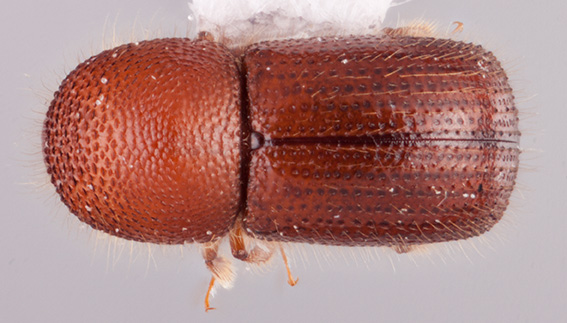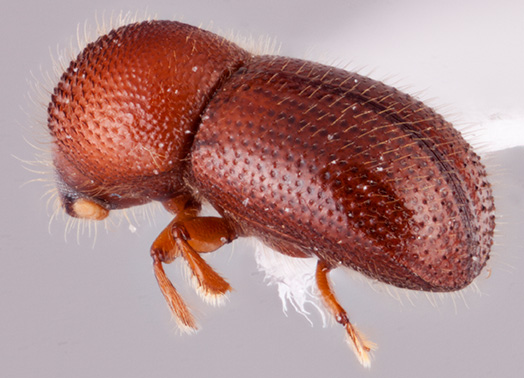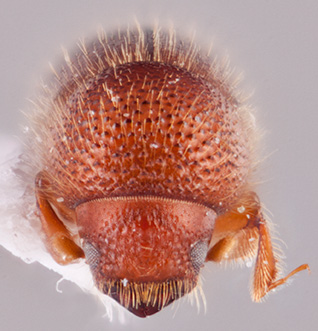Ambrosiodmus rubricollis
|
Ambrosiodmus rubricollis lateral; R.K. Osborn |
|
Ambrosiodmus rubricollis dorsal; R.K. Osborn |
|
Ambrosiodmus rubricollis declivity; R.K. Osborn |
|
Ambrosiodmus rubricollis frontal; R.K. Osborn |
Taxonomic history
Xyleborus rubricollis Eichhoff, 1876a: 202.
Ambrosiodmus rubricollis (Eichhoff): Wood, 1989: 170.
Synonyms
Xyleborus taboensis Schedl, 1952b: 65. Wood, 1989: 170.
Xyleborus strohmeyeri Schedl, 1975b: 457. Wood, 1989: 170.
Diagnosis
2.5−2.8 mm long (mean = 2.70 mm; n = 7); 2.45−2.55 times as long as wide. This species can be distinguished by elytralelytral:
pertaining to the elytra
declivitaldeclivital:
pertaining to the elytral declivity
interstriae with uniformly sized and spaced granulesgranule:
a small rounded protuberance, like grains of sand
 from basebase:
from basebase:
point or edge closest to the body; opposite of apex to apexapex:
to apexapex:
point or edge furthest from the body; opposite of base
 ; declivitaldeclivital:
; declivitaldeclivital:
pertaining to the elytral declivity
interstriae slightly elevated and bearing erecterect:
pertaining to setae that have their apices directed away from the body and appear straight
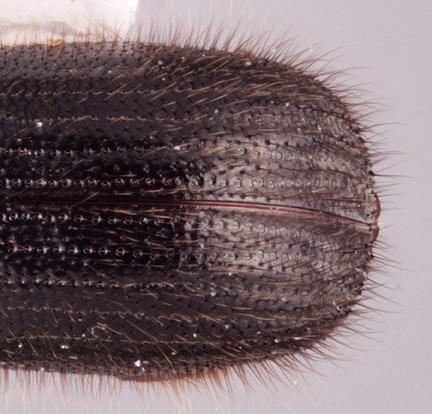 hair-like setaeseta:
hair-like setaeseta:
small hair-like or scale-like structure
, setaeseta:
small hair-like or scale-like structure
located ventrad of each granulegranule:
a small rounded protuberance, like grains of sand
 ; declivitaldeclivital:
; declivitaldeclivital:
pertaining to the elytral declivity
surface shiningshining:
appearing glossy or bright in luster; referring to a surface that is polished and reflects light well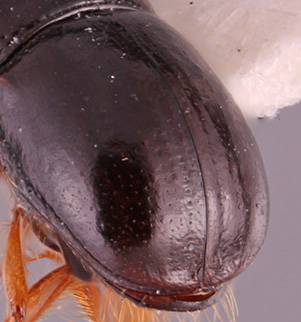 , and light red-brown color.
, and light red-brown color.
May be confused with
Ambrosiodmus brunneipes and A. conspectus
Distribution
China (Anhui, Beijing, Chongqing, Fujian, Guangdong, Guangxi, Guizhou, Hebei, Heilongjiang, Hong Kong, Hunan, Jiangxi, Shaanxi, Shandong, Sichuan, Xizang, Yunnan, Zhejiang), Japan, South & North Korea, Laos, West Malaysia, Taiwan, Thailand, Vietnam. Introduced to Australia (Wood and Bright 1992Wood and Bright 1992:
Wood SL, Bright DE. 1992. A catalog of Scolytidae and Platypodidae (Coleoptera), Part 2: Taxonomic index. The Great Basin Naturalist Memoirs 13: 1-1533.), Italy (Faccoli et al. 2009Faccoli et al. 2009:
Faccoli M, Frigimelica G, Mori N, Toffolo EP, Vettorazzo M, Simonato M. 2009. First record of Ambrosiodmus (Hopkins, 1915) (Coleoptera, Curculionidae, Scolytinae) in Europe. Zootaxa 2303: 57-60. https://doi.org/10.11646/zootaxa.2303.1.4), North America (Bright 1968Bright 1968:
Bright DE. 1968. Review of the tribe Xyleborini in America north of Mexico (Coleoptera: Scolytidae). The Canadian Entomologist 100: 1288-1323. https://doi.org/10.4039/Ent1001288-12), and South America (Wood 2007Wood 2007:
Wood SL. 2007. Bark and ambrosia beetles of South America (Coleoptera: Scolytidae). Brigham Young University, M.L. Bean Life Science Museum; Provo, 900 p.).
Host plants
a polyphagous species (Faccoli et al. 2009Faccoli et al. 2009:
Faccoli M, Frigimelica G, Mori N, Toffolo EP, Vettorazzo M, Simonato M. 2009. First record of Ambrosiodmus (Hopkins, 1915) (Coleoptera, Curculionidae, Scolytinae) in Europe. Zootaxa 2303: 57-60. https://doi.org/10.11646/zootaxa.2303.1.4), which usually attacks smaller stems (Browne 1961bBrowne 1961b:
Browne FG. 1961b. The biology of Malayan Scolytidae and Platypodidae. Malayan Forest Records 22: 1-255.)
DNA data
Sequences available for COI and CAD.
COI: HM064049.1; MN619828; MN619829; MN619830; MN619831; MN619832
CAD: HM064228.1; MN620123; MN620124; MN620125; MN620126; MN620127


